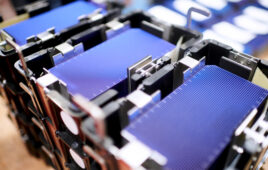Renewables developer and operator Terra-Gen has hired Mortenson to construct the Edwards & Sanborn solar and energy storage project located in Kern County, California. The project consists of 1,118 MW of solar and 2,165 MWh of energy storage. It is currently the largest single solar + storage project to reach this milestone.
“Selecting the right partner to execute a project of this scale coupled with cutting edge battery experience was paramount for Terra-Gen, and Mortenson was a natural fit,” said Brian Gorda, Terra-Gen’s vice president of engineering. “Terra-Gen is excited to push the industry to new heights and build a plant that provides energy for all hours of demand.”
The Edwards & Sanborn project is located near several operating wind and solar projects in Kern County, California. Mortenson is the full EPC contractor on both the solar and energy storage scopes. Site construction will commence in Q1 2021 with expected completion in Q4 2022.
Solar production on the site will utilize more than 2.5 million modules and energy storage will utilize more than 110,000 lithium-ion battery modules.
“The Edwards & Sanborn solar and energy storage project is industry-changing and during this challenging 2020 will redefine the impact these systems will have on our clean energy future,” said Trent Mostaert, Mortenson’s vice president and general manager of solar. “We are proud to combine our solar and energy storage design and construction expertise with Terra-Gen’s development capabilities to deliver a world-class energy facility.”
At peak construction, more than 700 people will be employed on-site at the project.
News item from Terra-Gen





“Renewables developer and operator Terra-Gen has hired Mortenson to construct the Edwards & Sanborn solar and energy storage project located in Kern County, California. The project consists of 1,118 MW of solar and 2,165 MWh of energy storage. It is currently the largest single solar + storage project to reach this milestone.”
Design is as important as size, I’d like to see a deep dive in to how this project will be designed and operated. 1.12GW/2.17GWh is a two hour solution. IF this is designed to be a “stepped” generation facility you could design a 50MWh generated output for 40 plus hours. Something like this would come in handy during a heat wave like the one last August that caused a black out. Having an asset that could serve the grid demand with 500MWh of generation for 4 hours could be just enough to keep the grid up. Having this flexibility in one asset would be the death of fueled generation and adoption of flexible output and the ability to sit on the transmission line with large scale energy storage that would allow a day ahead market operation.